By now, most hand-gunners are familiar with the existence of the Springfield Armory line of XD pistols, which includes the XD, XDM, and XDS in chambering of 9mm, .40 Smith and Wesson, and .45 ACP. The XD line (known as the HS2000 in its Mother country of Croatia) was introduced in 2002 and was considered, by some, as a direct threat to the Glock G21. The XD line was well-received by the community of hand-gunners. I succumbed to the appeal myself and purchased a 4-inch “Service” model in .45 ACP flavor after they first were available. The appeal of the XD 4” “Service” model still remains today, as it is part of my collection.
In 2009, Springfield Armory introduced the XDM series of pistols. The XDM series of pistols was not offered as an upgrade or to replace the XD series, but was offered as a completely different line of pistols with advanced features over the XD series for discerning customers. I did not indulge at the time, since I already had an XD and it was not destined to be a carry piece.
Recently, I became interested in setting the 1911 aside for a while as my EDC and a search for a high-capacity, polymer pistol in .45 ACP for Winter carry began in earnest. The selected pistol would be carried IWB and concealed. Pistol size and carry weight, especially when you exceed 10-rounds, needs to be considered.
Carrying the XDM 4.5 in deep concealment would be quite a chore, as a high-capacity, polymer pistol in .45 ACP falls somewhat short of an ideal pistol to conceal. From the many selections of high-capacity, polymer pistols in .45 ACP, the XDM came to the forefront of my search for a high-capacity, polymer pistol in .45 ACP for carrying IWB with any modicum of concealability. I already had the XD, but wanted an “updated” version of this pistol that would provide “Match Grade” and a few other features. Some say that the “M” in XDM simply means more “Money” than “Match” and I would soon determine if that was true – or not. Some also say that the term “Match Grade” is also a marketing ploy and I talk about that later in this write-up.
For informational purposes, Wikipedia provides the following regarding the XDM:
The most noticeable differences between the previous XD models are the XDM’s interchangeable back-straps and match-grade barrel. The XDM series of pistols won Handgun of the Year in 2009.
All XDM series of pistols comes with a ‘Match Grade” barrel and trigger, and an ambidextrous magazine release. Match Grade barrels are manufactured to tighter tolerances and custom-fitted for better accuracy and to make the pistol “competition ready”. The XDM is a polymer framed handgun with full steel inserts and a mounting rail.
While cosmetically looking superior to the original XD guns with its “all terrain” grip pattern, the angle and depth of each contour in the grip has been calculated for maximized control vertically, horizontally and torsionally. The Major Grasp Slide Serrations were modified for a better more penetrating grasp. All XDM pistols come with grip and trigger safety mechanisms and a loaded chamber indicator at the top of the gun just behind the barrel. A traditional manual safety is an optional feature (Author’s Note: But only on certain XD models). The surface of the metal has undergone a Melonite treatment, a salt bath nitriding process which leaves a hard, corrosion-resistant surface. Unlike the previous generation of XD handguns, the XDM does not require pulling the trigger to disassemble the gun, making field stripping safer and faster.
While some of these things provided the impetus for purchasing the XDM 4.5, the real story behind the purchase needs a bit more of detail and that is the purpose of this review.
But first, I have to admit that I also have a Springfield XDM 3.8 Compact in .45 ACP (read my review of this pistol @ https://guntoters.com/blog/2016/05/29/springfield-armory-3-8-compact-45-vs-ruger-rs1911cmd-a/). So why then, some would ask, consider the Springfield XDM 4.5 in .45 ACP? That is a valid question and the answer simply comes down to balance. The Springfield XDM 3.8 in .45 ACP, in my opinion, is well-suited for the primary 10-round magazine (the same could be said, I suppose, for the Glock G36). Substitute a 13-round magazine with grip sleeve and the Springfield XDM 3.8 in .45 ACP becomes not so well balanced. A pistol with a longer barrel length would be better balanced using a 13-round magazine. A “service-length” barrel of 4” to 5” inches would be optimum, in my opinion. A 4.5” barrel is a good trade-off for concealability, sight acquisition, projectile velocity, and balance of the pistol when handling it.
Another factor for the selection was concealability (I address this later in the review). A handgun’s short, wide-butt is far easier to conceal in hot weather than a long, wide butt. The Springfield XDM 4.5 in .45 ACP is more intended for cold weather carry when concealing a long, wide pistol butt is doable with the proper clothing, holster, and holster cant. With that aside, let’s get into the meat of the matter.
Obviously, there are other factors to be considered when choosing a high-capacity pistol for IWB carry and I attempt to address some of those factors throughout the write-up and in closing the article.
THE BASICS:
Note: The Springfield XDM 4.5 is also available in 9mm and .40 Smith and Wesson chambering.
It seems lately that some manufactures are going all out in texturing pistols for appeal and they may be going way overboard in that department. There are people who like clutter and people who do not like clutter. Fashion over form seems commonplace with some pistol designs. Fortunately, Springfield has not completely succumbed to that thinking and has attracted and retained some customers, including me, because of that fact.
Of most of the pistol manufactured, I think that Glock and Springfield are visually appealing pistols. The clean lines of the Glock pistol are obvious and are visually appealing. Springfield Armory has an appeal of its own, although the pistols are somewhat cluttered. Clutter; however, can be made to seem uncluttered. Springfield Armory has, what I believe to be, uncluttered clutter. The Springfield XDM 4.5 exhibits blended lines but yet an aggressiveness in texture where needed.
The 4.5-inch barrel and grip size lends to the balanced look of the pistol. Any shorter of a barrel or any shorter of a grip would take away that balanced look and feel.
The XDM 4.5 is not a svelte pistol in any form or fashion. It is a handful of pistol and in no way is “compactness” one of its virtues. The XDM 4.5 indicates that it is all business, but can be used for pleasure as well. The XDM 4.5 is, after all, in the class of “service” pistols, which normally would be carried OWB and on a sturdy belt and secure holster combination, or planted within a quick-access safe for home defense purposes.
The XDM 4.5, for all appearances, is a well-made, heavily-constructed pistol. The XDM 4.5 simply looks like a heavy-weight contender, and the truth of the matter is, it is.
FIT and FINISH:
As you would expect from Springfield Armory, the fit of all things mechanical is excellent – internally and externally.
The Melonite treatment to the slide and barrel is excellent.
The polymer frame is well constructed and metal-reinforced in critical areas.
All in all, the XDM 4.5 is a robust package worthy of, if he were alive, the notice of Bill Ruger.
SLIDE AND BARREL:
The slide has received a full Melonite treatment except in the areas of normal metal-to-metal contact; what should be shiny is.
The Springfield Armory logo is nicely laser-etched on the top of the slide just forward of the chamber opening. On the left side of the slide, you will find XDM-45ACP and 4.5 nicely laser-etched. Right side slide laser etching consists of; the serial number just to the rear chamber opening, XDM just forward of the chamber opening, and SPRINGFIELD ARMORY USA midway at the lower edge of the slide. Talk about branding!
Chevron-style serrations adorn the slide in the XDM 4.5 front and rear and provide an excellent surface for gripping the slide where gripping is performed over-hand or from the rear (sling-shot). The serrations carry well into the beveled top of the slide.
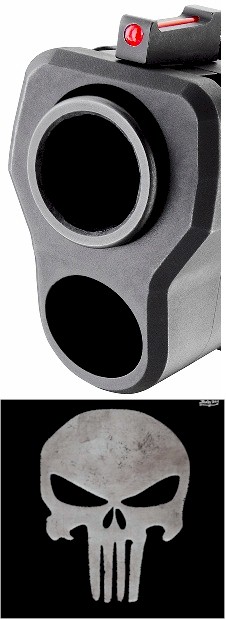 The front of the slide is nicely beveled at the muzzle end and any bad guy worth his salt should appreciate the time and effort that Springfield Armory put into the pistol so that the muzzle looks pleasing to those who might view that end of the pistol in times of stress. However artistic the muzzle end of the pistol appears, the very large hole at the end of the muzzle says that this pistol is serious business. The shape of the front of the slide is somewhat similar to that of skull (like that of the “Punisher”) when looking at the muzzle face on. I wonder if there was any subliminal message in the slide’s front-end design.
The front of the slide is nicely beveled at the muzzle end and any bad guy worth his salt should appreciate the time and effort that Springfield Armory put into the pistol so that the muzzle looks pleasing to those who might view that end of the pistol in times of stress. However artistic the muzzle end of the pistol appears, the very large hole at the end of the muzzle says that this pistol is serious business. The shape of the front of the slide is somewhat similar to that of skull (like that of the “Punisher”) when looking at the muzzle face on. I wonder if there was any subliminal message in the slide’s front-end design.
The slide tapers nicely upward from the bottom to slim down the profile of the slide. While this might not matter to some, a slimmer profile means easier concealment and my intention for the XDM 4.5 is to conceal it.
The “Match Grade” (see TRIGGER for more information about the term “Match Grade”), 11-degree crowned barrel receive the full Melonite treatment from the fore-end all the way rearward to the aft end. The barrel incorporates a hefty locking block, a fully supported and highly polished ramp entry into the chamber and is simply awesome in appearance. With 4.5 inches of six grooves with a 1:16 rate of twist, the .45 ACP projectiles should be extremely pleased as they find their way to the target. The word “MATCH” is laser-etched on the right side of the chamber as is the serial number and caliber of the pistol. One thing can be said about a barrel with a .45 caliber bore; it cannot be questioned if the chambering is for a .380, 9mm, or even misconstrued for a 10mm (.40 Smith and Wesson). The .45 caliber stands out in a crowd of calibers.
A FLGR and a very hefty non-captive recoil spring are beneath the barrel. Unlike the captive recoil spring system on the XDM 3.8, the 5.25 and 4.5 versions of the XDM do not have a captive recoil spring. These means that caution should be undertaken when disassembling and assembling the recoil system, as the recoil spring is under extreme tension during both disassembly and assembly.
Springfield XDM 4.5 Update – Guide Rod Wear:
When I was cleaning the XDM 4.5, I noticed some scarring on the guide rod (see accompanying image). The scarring definitely seems to be caused by the recoil spring.
In the picture, the scarring seems to be normal surface wear of the recoil spring rubbing against the guide rod. However, if I scrape a finger nail across the scarring, I can feel some very fine roughness. After running the XDM 5.25 I compared the two guide rods; there was no scarring of the guide rod on the 5.25 guide rod. However, time reveals all and normal and abnormal wear will reveal itself.
I thought at first to contact Springfield, but I decided to try and troubleshoot the issue myself first. I ordered a solid stainless steel guide from Wolff Springs along with a companion #18 (the standard spring rate for the .45ACP version of the pistol) recoil spring. If the issue persists after the swap-out, then I’ll contact Springfield.
A week after ordering, the SPRINGFIELD XDM GUIDE ROD w/SPRING 18LB (Part No. 54318) was received, quickly installed in the pistol, and checked for proper operation. Some minor differences existed between the Wolff guide rod and spring and the standard guide rod and spring; The Wolff recoil spring was one turn less than the standard recoil spring and the base of the Wolff guide rod was minutely smaller than the standard guide rod. Neither issue was a concern.
The guide rod to slide fit is perfect and it matches the finish of the XDM. Only use will tell if the original issue is resolved.
“Wolff solid recoil guide rods for the Springfield 4.5″ XD(M) Series pistols allows the use of Wolff recoil springs in various weights to allow tuning of the recoil function. Wolff XD(M) solid guide rods are a precision, hi-quality one piece steel guide rod. Designed for optimum performance they replace the standard factory recoil system. Rods are hardened to a minimum RC-55 for durability. Available in a durable black finish.” – Source: W.C. Wolff Company
I’ll update this review with future guide rod and spring information as applicable.
Aside from the sights (see, SIGHTS), the top of the slide incorporates a tactile and visual Loaded Chamber Indicator that allows you to observe if a cartridge is in the chamber. When the Loaded Chamber indicator is up, the firearm is loaded and ready to fire.
The Extractor is internal to the slide and is a feature that I prefer. Not only does an internal extractor add to the visual appeal of the pistol, it is also tucked away from the elements and possible external FOD.
Moving to the rear of the slide (the friendly end) you will find the Striker Status Indicator. When the pistol is cocked, a small pin protrudes from a hole in the Striker Locking Plate. While the Striker Status Indicator does not indicate if a cartridge has been chambered, it does indicate that the pistol is ready to fire. However, one should always treat the firearm as if it was loaded. If the Striker Status Indicator pin is showing and the Loaded Chamber Indicator is in the up position, you can be assured that something is going to come out the barrel when the trigger is pulled – Snap Caps are not included in this assessment.
FRAMING IT IN:
The metal-reinforced polymer frame is substantial and, in many ways, I feel is superior to the frame found on Glock pistols. My hand just falls right into place on the XDM 4.5 due to the grip angle; whereas, with the Glock pistol (any of them) it seems that my hand is constantly searching for that “sweet spot.”
For you folks who just demand that a pistol must have a means of attaching accessories, the XDM 4.5 will meet that demand. An under-rail with three slots should allow the mounting of your favorite light, laser, light/laser combination, or even a very small vertical hand-grip. Since I like a snack during a good gunfight, I just may rig up a mount to hold a couple of “Slim Jim” min-bites.
Just rearward of the rail, you will find the serial number plate.
The texture of the grip area, while aggressive, is not so aggressive that it hurts the hand and/or leaves impressions in the hand as with the XDS series of Springfield pistols. The hand just seems to gravitate to the texture naturally. The XDM 4.5 (and XDM 3.8 Compact) is just one of those pistols where I don’t feel like the pistol is sliding around in my hand and that means quite a bit in regards to control and handling of a pistol.
The only thing that I would like is finger grooves, but that is a personal “like” and I could add a grip sleeve with finger grooves to the handle, but that would increase the width of an already wide grip. As it is, the grip is just fine for most uses. After getting used to a “finger groove” grip on my 1911 pistols, I just feel a “wanting” on other pistols. But, back to the existing grip.
Also included in the grip area is more “bill-boarding” in the form of XDM, MADE IN CROATIA, and SPRINGFIELD INC. GENESERO ILL, which to me is more acceptable than “Grip Zone,” which I consider an insult to my intelligence – I know what to hold and how to hold it, thank you.
Whether you are a right or left-handed shooter, there is a nice groove in the upper part of the grip that the thumb seems to just fall into. The “groove” also serves as a guide for the trigger finger to the trigger on the opposite side of the frame. If you are a “high-thumbs” shooter, as I am with a 1911, the thumb grooves take a bit of getting used to, but using them keeps my thumb away from the Slide Lock Lever; the pressing of which could result in a failure of the slide to lock back on the last round.
The frame is well-railed to capture as much of the slide as possible. The front steel rails (part of the locking block) measures approximately 35.95mm (1.45-inches) in length and the rear polymer rails (integral to the frame) measure approximately 30.8mm (1.21-inches) in length. All makes for a very solid slide-to-frame fit.
The frame incorporates the Disassembly Lever and Slide Stop Lever (See; I AM IN CONTROL).
One of the features of the XD line of pistol that I can appreciate is that the Locking Block is robust and well-embedded into the meat of the frame. One of the failings of the Glock pistol (excluding the G43 and G42) is that the area surrounding the upper Locking Block pin is susceptible to damage after very high round counts or the over-use of +P ammunition. I have personally seen two examples of cracked Glock frames at this point of contention. The Locking Block in the XDM is well-designed, robust, and well-mounted, in my opinion. The Locking Block also serves as the front rail for the slide.
One of the features of the XD series of pistols is the integral Grip Safety; one of the features that many of us 1911 operators appreciate. The Grip Safety must be pressed to fire the pistol. The Grip Safety must also be pressed to move the slide to the rear, which may be awkward at first for some, but is easily managed by most.
The trigger incorporates the now-seems-to-be-standard integral Trigger Safety Lever (otherwise known technically as the Trigger Flapper). The trigger finger must be inserted fully into the trigger guard and engage the trigger face, which allows the trigger to be pulled rearward. There is more information about the trigger characteristics in TRIGGER.
The trigger guard incorporates a serrated front finger rest for those who prefer one. The trigger guards is large enough for a gloved hand and the frame incorporates a slight well to the rear of the trigger guard to help the rest of the fingers to get as close to the bottom of the trigger guard (and high on the back-strap) as possible.
The trigger reach (the distance from the center of the trigger face to the rear of the back-strap with the grip safety pressed) is approximately 2-5/8 inches. This means that folks with small of chubby hands should have no problem reaching the trigger and selecting a grip insert for your hand may help in that department.
The XDM 4.5 came with three back-strap grip adapters. The No 1 (the smallest) grip adapter was installed on the pistol out of the box and will remain on the pistol for my hands. That may sound funny coming from somebody who sometimes puts grip sleeves on Glock pistols to increase the grip width, but the grip of the pistol feels right for my hand. Given the grip angle of the pistol, the grip angle has the feel of a 1911 or a CZ75 and I like that feeling.
The pistol has an excellent beaver-tail area that aids in getting the shooting hand high on the back-strap but eliminates any concern about slide bite. The wide beaver-tail also helps to distribute recoil to the shooting hand.
The grip is wide and long and there is no doubt about that. There is enough space to place all of my fingers around the grip area with a bit of grip left over. The XDM 4.5 grip area is that of a full-size service pistol. The grip area on the XDM 3.8, even with the extended 13-round magazine and grip sleeve, does not feel as good as the grip on the XDM 4.5 for me.
Turning to the magazine well, we find a beveled one, which definitely assists in slapping home a wide-body double-stack magazine.
Just behind the trigger guard, we find ambidextrous magazine release buttons that should make lefties happy. In fact, they make this “righty” happy when I am operating a pistol left-handed.
The magazine release buttons are extended but not obtrusively so. The magazine release buttons can be operate easily by thumb or finger, but are a little stiff and feel slightly gritty when new; a quick spot of Ballistol during my “prepping” the pistol for duty smoothed-out out the magazine release button stiff and gritty issue. Push a magazine release button and magazines drop free as is to be expected.
MAGAZINES:
The XDM 4.5 ships with two 13-round stainless-steel, highly-polished magazines (Where allowed. Otherwise, capacity is limited to 10-rounds.), and the magazines are of excellent quality and construction.
Self-lubricating polymer followers and a removable polymer base plate rounds out the magazine features. Witness holes and stamped numbers along the spine of the magazine provide a visual means for assessing round count. Now, let’s talk about capacity.
While you can get thirteen rounds of .45 ACP in the magazines, you may not get the magazine fully inserted into the pistol with the slide closed without some serious effort – when the magazines are new. I noticed the same thing with the XDM 3.8 and its standard 9-round magazine. If the slide is rearward and a topped-off magazine is inserted, there is no issue. So, what does this really mean?
It means that you need to let the magazine(s) sit fully loaded for a few days to “condition” the magazine spring. An alternative is to just use the darn things; they will eventually break-in and the issue will resolve itself.
If I anticipate “Combat Reloads” with fresh, out of the package magazines, I would download the magazines by one round – 12 rounds. Initial loading would be 12 in the magazine and one round chambered for a total of thirteen rounds, which is the designated loading for the pistol. The reality of it is that I would rather have one less round in the magazine and be assured that I can load that magazine into the pistol with issue rather than max out the magazine capacity and possibly damage the magazine, or the pistol, by using excessive force when inserting a fully-loaded magazine into the pistol. While I may live with one less round, the chances are that I won’t live with a pistol rendered useless in my hand.
Here is another part of reality, the PARA-USA 14.45 1911 has the same issue. A fully-loaded fourteen round magazine will not lock into the pistol without using excessive force if the slide is forward. In other words, the PARA-USA pistol is a fourteen round pistol – one chambered and thirteen in the magazine. Nowhere in the specifications of the PARA-USA state 14+1, nor is there a statement in the XDM 4.5 that it is a 13+1 pistol, nor is there a statement that the XDM 3.8 is a 9+1 pistol.
There are, of course, some pistols that will allow you to insert a fully-loaded magazine, chamber a round, and then top off the magazine. It appears that the XDM is not one of those until the magazines are fully broken in. I have ordered a couple of ProMag 13-round magazines for the XDM to see if this is an issue with the magazines that came with the pistol or if it is a “common” issue. If the ProMag magazines work out (are able to be inserted into the pistol with a full compliment of thirteen cartridges on a closed slide), then the issue is with the provided magazines. However, the magazines also need to be 110% reliable. I’ll update this review with the results of the magazine evaluation.
In the case of the XDM 4.5, the “if it doesn’t fit, force it!” frame of mind just will not work out well for you.
With a broken in magazine load of thirteen rounds (or less), the magazine will rattle inside of the mag well slightly. That is just an indication of a properly inserted magazine in this case. That also means that you can carry a 13+1 load-out in the pistol.
I AM IN CONTROL:
In addition to a trigger safety, a drop safety prevents the striker from releasing if the gun is dropped or exposed to a significant impact. As of 2008, 4 in and 5 in XD .45 ACP Service models are available with an optional ambidextrous frame-mounted thumb safety. This option is now available in 9mm, .40 and .45 ACP pistols. As far as I can tell at the time this article is being published, a thumb safety option on the XDM models is not available.
The Disassembly Lever is a simple contoured lever on the left side of the pistol that allows you to remove the slide after the slide is pulled fully rearward and locked into place with the Slide Stop Lever. The Disassembly Lever is nicely serrated to provide a good grip when handling the lever.
The Slide Stop Lever is just rearward of the trigger guard and is easily accessible by the thumb of the shooting hand – in most cases. The Slide Stop Lever is nicely serrated and shaped for friendly operation. The Slide Stop Lever, of course, allows the slide to lock back on the magazine after the last round in the magazine has been fired. It was not intended to be a “Slide Release” and pushing or pulling the slide rearward on a fresh magazine would be best to prevent damage to the slide locking point. During combat or competition; however, I’ll leave the operation of the slide up to the operator.
SIGHTS:
The XDM 4.5 cones standard with a two-dot rear sight and a red fiber-optic front sight. Both front and rear sights are drift – adjustable for windage but no consideration for elevation is provided.
Frankly, I am not all that enthused with fiber-optic front sights on a “duty” pistol, but fiber-optic sights seem to be the rage these days. Personally, and if the XDM 4.5 is totally accepted as my EDC, a set of substantial night sights will no doubt be installed. I would have preferred a metal dot sight been installed, as is on the XDM 3.8 Compact, but I can live with the current sight arrangement on the XDM 4.5 until I decide otherwise.
With the 4.5 version of the XDM, these old eyes do welcome the 6.875 (6-7/8) inch sight radius over the 6.625 (6-1/8) inch sight radius of the 3.8 version.
The XDM 4.5 cones with two light pipes, red and green, if you wish to change, or need to replace, the front sight pipe. Instructions for doing so are included in the Owner’s Manual.
TRIGGER:
So, let’s talk briefly about the “Match” trigger; the other part of the “M” in XD. First, there is this:
It should be noted that the term “Match Grade” has no objective definition and it is commonly used to describe firearms or ammunition of varying quality and may never be found in use by professional or amateur competition shooters. For instance, both Kimber and Nighthawk Custom fit “Match Grade” triggers; it is difficult to objectively describe the quality of a trigger (even a measurement of 4.5 pounds doesn’t account for creep, over-travel, pre-travel and grittiness), by the same token, it is difficult to dispute the claims of either company. However, the “Match Grade” trigger on a Kimber is nowhere near the quality of that on a Nighthawk Custom. Para-Ordnance claims to use “Match Grade” barrels on even their “Elite” budget priced handguns, but the fitting of the barrel to the slide, frame, link and bushing is critical to accuracy, so the quality of the barrel may be of no consequence to the pistol’s ultimate accuracy potential. Moreover, a truly match grade barrel (in use by competition shooters) from KKM or Bar-Sto will cost nearly a third of the total price of a Para-Ordnance Elite pistol, still requiring careful fitting by a skilled gunsmith, it is unlikely that such expense was taken in the manufacture or fitment of these “Match Grade” barrels. Such comparisons could be made at length, but the consumer should be aware that the term “Match Grade” carries no real, objective meaning within the firearms industry and, in many cases, it may be nothing more than the marketing department doing their job.
– Source: Wikipedia (https://en.wikipedia.org/wiki/Match_grade)
At his point, I will say that the trigger on the XD is better than the trigger on the XDM. The trigger on my XD exhibits a very short travel and a crisp let-off while the trigger on the XDM 4.5 (that I have) exhibits a short take-up until resistance is felt. Then, there is a small degree of travel through the resistance until the striker is released. The let off; however, is crisp. The resistance does not “feel” mushy, it just feels like a constant resistance until let-off is obtained. Once resistance is felt, the trigger feels like a very short throw, smooth, double-action trigger with no staging.
The trigger actually feels good, but is obviously different than a 1911 trigger or that found on other pistols that I have operated – it stands on its own merits. The release is very close to the frame and reset is more toward the beginning of the resistance. The pull weight average of the trigger is at 6.8 pounds (according to my trigger pull gauge) on this particular pistol, but in actuality I find that trying to determine the actual trigger pull weight on a pistol equipped with a trigger safety is iffy at best. The trigger actually feels lighter when pulled. Now some may say that 6.8 pounds of trigger pull is too heavy. To heavy for what, I ask? I you purchase this pistol for target practice or precision target shooting, I would probably agree that it is too heavy. For defensive use, as is the intention of this pistol, the trigger is fine with me and I welcome a trigger that is neither too light nor too heavy to use in a stress situation. The trigger is constant and consistent throughout its operation and that works for me. I am going to say that the trigger on the XDM 4.5 is a “Court Defensible” trigger and should serve fine for most.
But, I would like to go a little further into the XDM operation and especially the trigger because the trigger was one of the factors for my choosing the XDM over the Glock G21 (or even G30).
The XDM design integrates classic auto-loader mechanics with several distinctly unconventional features. The basic operating mechanism employs a familiar Browning-type cam-ramp, tilt-barrel operation with a captive dual-spring recoil guide assembly. The ignition mechanism is striker-fired and requires a partial rearward motion of the slide (approximately 3/4 inch) to cock the system and ready the trigger. If the gun is dry-fired, or in the event of a misfire, the trigger cannot accomplish a repeat strike until/unless the slide is racked. In external aspect, this system appears to operate (and feel) much like the familiar mechanism of a Glock, as does the hinged “Glock-like” trigger-safety lever that prevents rearward trigger movement unless pressed by the user’s trigger finger. However, the actual operating mechanics of the two designs are greatly different.
The XDM mechanism completely cocks (pre-loads) the spring-charged firing pin so that the only function provided by the trigger pull is to release the sear and fire the gun. By contrast, the Glock “Safe Action” only partly pre-loads the firing mechanism, and the trigger pull physically completes the cocking action as well as releasing the firing pin. The XDM is therefore a true “single-action” trigger design because its trigger only performs one function–releasing the firing mechanism. The Glock is a true “double-action” trigger design in that its trigger contributes to the actual cocking of the mechanism as well as releasing it.
To describe the process in detail: After the XDM slide travels rearward about 3/4 inch, the spring-loaded sear “captures” a cocking lug on the firing pin, holding the pin compressed fully to the rear against the pressure of the firing pin spring when the slide travels back forward (either after a short manual retraction of the slide or after the slide’s full rearward travel in the firing cycle). A pull on the trigger then moves the trigger bar and firing pin safety lever linkages forward, depressing the sear and releasing the firing pin to fire the cartridge. The XDM pistol may “feel” like a DAO mechanism, but it is not. It acts like a DAO, but it isn’t, mechanically. Springfield’s official term for the mechanism is Ultra Safety Assurance Action Trigger System – or “USA Action” for short. Catchy, isn’t it?
Another unique XDM design aspect is the Grip Safety that prevents the gun’s trigger from being squeezed unless it is fully pressed. The XDM Grip Safety also freezes the slide. If the grip safety isn’t fully pressed, you can’t pull the trigger, and you can’t pull the slide to the rear to load an empty chamber or clear a loaded chamber. you also can’t lock the slide back on an empty gun, whether the magazine is in or out. Plus, there is a separate internal Firing Pin Block that is deactivated only when the trigger is pressed all the way rearward to the point of striker release.
DISASSEMBLY/INSPECTION/LUBRICATION/ASSEMBLY:
Disassembling the XDM 4.5 is not unlike many pistols that incorporate a rotational Disassembly Lever in their design; lock the slide back, rotate the disassembly lever to the vertical position, hold the slide and press the Slide Lock lever to release the slide, and then slowly remove the slide from the frame.
Disassembling the slide on the XDM 4.5 (and 5.25) is slightly different due to the coil spring that is not captivated. I place the slide on a soft surface so as not to damage the sights. I hold the recoil spring and guide while pushing the base of the guide rod forward with the thumb of my other hand to push it out of its position on the barrel. I slowly allow the guide rod to move rearward and once I feel all the tension go out of the recoil spring, I then remove the recoil assembly out of the slide.
 Whenever I disassemble a firearm, I always inspect areas susceptible to wear, especially at contact points where parts slide and/or move against each other, to determine if the wear is normal or abnormal.
Whenever I disassemble a firearm, I always inspect areas susceptible to wear, especially at contact points where parts slide and/or move against each other, to determine if the wear is normal or abnormal.
Springfield does not include lubrication instructions in the manual. Basically I use a light film of Lubriplate NO. 130-A on all slide rails, barrel, lock-up points and surfaces, and any surface that looks shiny. This pistol is not going to be used in harsh climates or conditions. I have used Lubriplate NO. 130-A for years on semi-automatic pistols, rifles, and carbines for years. Your choice of lubricants, of course, is up to you.
During an initial operations check, I noticed that the magazine release assembly was slightly gritty in operations. A very light dab of Ballistol (another product that I have used for years) removed all vestige of grittiness.
Once I was satisfied with my inspection and lubrication attempts, it was time to assemble the pistol. The non-captured recoil spring presents a challenge, as it is quite healthy in spring rate. I found it best to hold the recoil assembly in place with my left hand while pushing against the base of the guide rod until the base of the guide rod fell into its locking notch on the barrel. This does take some “push” and there is a possibility that the guide rod base could slip away from the thumb. The left hand holds the recoil spring as it is being compressed and that helps prevent the recoil assembly from flying away into darkened corners of the room.
Once the slide is fully and correctly assembled, simply install the slide onto the frame, move it rearward until the slide lock point is reached and engage the Slide Lock. Rotate the Disassembly lever down until it is horizontal to the pistol. Grasp the slide and push it to the rear slightly to disengage the Slide Lock. Then, slowly allow the slide to go forward into battery. Perform a function check and you are done.
HOW IT FEELS IN THE HAND:
In my hand, the XDM 4.5 is one of the best wide-body, high-capacity pistol that I have held. There is no searching for a “Sweet Spot” in the grip, the pistol feels balanced in the hand although the weight of the pistol does shift to the butt when loaded, and the gun does not feel excessively wide (in my hand).
The grip angle feels as close to a 1911 as I have come across, albeit thicker, and that is alright with me. This is one pistol that I do not feel the need for a finger-groove grip sleeve as I do on some other polymer-frame pistols.
When I pick up the XDM 4.5, it feels as if it has some heft and robust feel to it and I actually like that feel.
A full and solid two-handed grip is no problem to achieve and I feel that I have more control over the XDM 4.5 than I have with the XDM 3.8 – even with the extended magazine and grip sleeve adapter. Because of the grip width and length, I am able to get more support hand on the grip where it should be as compared to a thin-gripped pistol like the 1911 and even some single-stack, striker-fired pistols.
TRANSITIONS:
When you shoot and carry a 1911 for most of your adult life as I have, shooting and carrying a larger (both in width and in grip length) takes some transitioning from one to the other. While I have shot wide-body pistols, they are not my standard fare for carry although I did carry a Bersa Thunder 45 Ultra Carry for some time, which is slightly wider than the 1911 but also quite a bit smaller. You can see by the images that not only is the XDM 4.5 larger that the 1911 but it is a LOT larger than what I am accustomed to. While a Rock Island Armory FS 1911 Tactical may have been one of the larger pistols that I have carried on a daily basis, it seems compact when compared to the XDM 4.5. But, I knew that I had to get my head (and hands) around a high-capacity pistol if I was going to be successful declaring it an EDC. And, to tell you the truth, I don’t know if I am going to be successful; the 1911 is more ingrained in my psyche than any other pistol. I felt; however, that if any pistol was going to sway my ways, the XDM 4.5 would be a good candidate.
TRIGGER TIME!
 A standard silhouette target was positioned ten-yards distant and served quite well as an evaluation point for the XDM 4.5.
A standard silhouette target was positioned ten-yards distant and served quite well as an evaluation point for the XDM 4.5.
I knew that going into this part of the evaluation was going to be a challenge. It was going to take a bit for me to get used to the width of the pistol for the most part and working with the unfamiliar grip/trigger combination. I have some experience on “wide-body” pistols so it was more getting acclimated with this particular pistol that I seriously intend to carry.
Although the magazines do hold thirteen cartridges, I would only be loading eight cartridges to break the magazine in. Cartridges consisted of; Aguilla 230-grain FMJ (830 fps), Perfecta 230-grain FMJ (850 fps estimated), Georgia Arms 230-Grain FMJ (810 fps), and hand-loads of 230-grain Xtreme FMJ over 5.6-grain of Unique (approximately 850 fps).
The first eight bench-rested rounds were to establish a sighting-point and from that point move into off-hand shooting for the remainder of the first shooting session. I had more confidence in the pistol than in my finely-tuned shooting stance and ultra-precision trigger control that I am widely not known for and which Rush Limbaugh might call “an unfair disadvantage over other shooters.” In other words, while I cannot make the pistol shoot better, the pistol can help me shoot it better – or so I hoped.
If you have followed any of my reviews, I have often stated my issues with indoor ranges. For some reason, and it may be the coating on the lenses of my glasses, my eyes have a difficult time making out the dot of the front sight on pistol that have them – even night sights. Normally, I just use the front sight profile rather than a dot for sighting – until the XDM 4.5 came along. The XDM 4.5 has been the first pistol with which I have actually been able to see the front fiber-optic sight while shooting at my local indoor range. Outside, the sights are clear and excellent. I was pleasantly surprised that I could actually line up three dots rather than use the front sight profile with the XDM 4.5. That is a big plus in my book.
I began the session with eight-rounds of Aguilla 230-grain FMJ and bench rested at ten-yards to establish a POA. The sights, elevation-wise, were spot on but impacts on target were slightly left of center. With initial sighting accomplished, I moved into off-hand shooting using my usual and undignified modified Weaver stance.
When you are used to shooting a thin, full-size 1911, there is a transition period until the hand starts to become accustomed to a wider grip. The grip of the XDM 4.5 felt comfortable and I felt like I had very good control of the pistol. Overall grouping; however, was still slightly left of center. I handed the pistol to one of my shooting companions and he also shot left of center. I handed the pistol off to another shooting buddy and he was placing shots more centered. I compensated for the left of center impacts and resigned myself to either compensating for the shots or drifting the rear sight right just a bit. I took a break from shooting to allow the barrel to cool a bit and the mind started clicking. I realized that I and my one friend were 1911 shooters; the other shooter usually shot a double-stack pistol and; therefore, was more familiar with a wide-body pistol. I decided, at that time, to run eight rounds with my trigger finger resting on the trigger with the pad of the finger rather than at the first joint that I usually use with the 1911.
The result of simply moving my trigger finger’s position on the trigger was impacts centering more than before. I then ran eight rounds to the head and placed all eight rounds in a 3-1/2 inch group centered in the head area at ten yards offhand. I had found the “sweet spot!” I then ran a full magazine in “Mozambique” drills and there was no problem placing hits center mass and center head at a reasonable pace. The XDM 4.5 is +on the money+ if the shooter does their job.
I ran one-hundred rounds through the XDM 4.5 this first outing and the pistol ran flawlessly; no FTFs, no FTEs, and no problems whatsoever with all ammunition used.
Recoil? Why yes I does and I am glad that you ask. At first I was surprised at the felt recoil. I guess that I wasn’t expecting a sharp impulse. It is not disconcerting, mind you, but it is just different from that felt with the 1911. I have to attribute the somewhat sharp felt recoil to the polymer frame and a lighter pistol than the 1911. The recoil comes straight back into the web of the thumb and feels sharper than the 9mm but not as sharp as the .40 Smith & Wesson in the same XDM line of pistols (yes, I have shot those as well). However, after firing several magazines I was getting quite accustomed to the recoil and rolled with it as I do the 1911.
The trigger was breaking in and I can state emphatically that the trigger on the XDM 4.5 is excellent. I did not notice any “heaviness” in the trigger – it was just a constant and consistent pull. I haven’t decided yet if I prefer the XDM 4.5 trigger over the XDM (or the 1911 for that matter), but the trigger on the XDM 4.5 is within my tolerance level for a trigger.
Durability and reliability are of utmost importance when selecting a firearm and the XDM did not disappoint. The XDM 4.5 was going to be a fine firearm to carry for my self-defense needs. So, let’s move on the “carrying” part of the equation.
EASE OF CARRY:
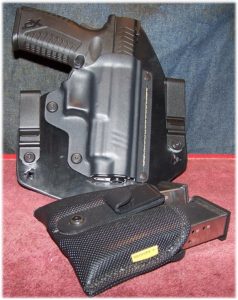
XDM 4.5 Housed in the ACE-1 GEN2 Black Arch IWB Holster with a Modified Remora Double Pouch Magazine Carrier
Although shooting a pistol is a large part of the overall equation, how well the pistol carries is another part and very few professional gun writers can tell you how a pistol carries over any period of time because they don’t carry them on the body for even a short time, or ease of carry is simply over-looked in their presentation. Most professional gun writers get the pistol for evaluation, provide a static review of them, and then take them to the range for a more dynamic review. I usually leave such reviews with a question, “The review was all fine and good but what is it like to carry the thing for a week?”
I am not going to tell you that the XDM 4.5 is an easy carry if you are considering packing it IWB. Obviously, a short-barreled, short-butted pistol makes for good concealment. Carrying OWB in a good holster supported by a good belt, the XDM 4.5 will be at home. Carrying the same pistol IWB will take some work. It is; however, doable and is going to take some effort on your part. But, you need to be honest with yourself. If you cannot effectively conceal a full size 1911 or a Glock G19, you might want to consider a compact pistol other than the XDM 4.5. A barrel can be concealed relatively well because it is mostly inside the pants, but there are even limitations to that. A pistol with a short butt (even a double stack) can be concealed with the proper clothing, holster, and the pistol being pulled tightly against the body. A pistol with a longer butt takes some planning.
I have found that by adding a little bit more forward cant to my IWB holster, the rear Z”point” butt of the gun is also pulled forward. This helps minimize “Printing” when bending over, but does not eliminate it. You still have to do your part. I also try to keep the grip of the pistol as close to the belt-line as possible – as long as it does not interfere with getting my hand on the grip or with the draw-stroke. I have long arms and a high riding firearm does not work for me; I am not that flexible anymore and I don’t want the bad guy to think that I am going into a seizure because of the way I have to access my firearm.
Since the XDM 4.5 has a relatively long barrel, and the slide width is relatively wide, thinking that the XDM 4.5 will lay as flat as my Government Model 1911 is detrimental thinking.
I use an IWB holster from Black Arch Holsters (formally SHTF Gear). I have several of their holsters and they just work well for me. You may have a favorite brand/type of holster and that’s fine – as long as it does the job for you. If it does not, you need to consider other holster options.
Not only do I need to effectively conceal the XDM 4.5, but also at least one spare double-stack magazine. It can get pretty crowded in these britches and I wish that I could say it was because of something other than a pistol and a spare magazine. Sadly, I can’t say that.
Initially, I left the cant (FBI 15-degree) of the Black Arch ACE-1 GEN2 IWB holster as it was received. The holster was very comfortable, but I still prefer a more forward cant than the FBI 15-degree, and moved the front mount up one hole. The cant was now perfect and the ride height acceptable. The butt of the XDM 4.5 rested snugly just below the rib cage and the butt of the pistol was far enough forward that it would be very hard to detect should I bend over at the waist.
Usually, I will perform surgery on a holster that has a sweat shield on it when I carry a 1911. The sweat shield will remain on this holster as the XDM does not have a thumb safety and does not interfere with getting my hand on the pistol.
With the Black Arch Holster properly adjust for depth and cant, the position of the holster on my body, a spare magazine or two in a modified Remora magazine carrier for IWB carry, and suitable attire, the XDM 4.5 is all but hidden from detection. Because of my manner of dress (I don’t have to go all “corporate” any more, I can dress pretty relaxed. I always wear a T-shirt, which serves as a barrier between me and the pistol. I normally wear over-sized work shirts or casual shirts with patterns other than Hawaiian, and Perry suspenders helps me to support and stabilize the load. (Note: Read my review of the Remora Double Magazine Carrier and my modification at: Product Review – Remora IWB Double Magazine Pouch and REMORA DUAL ACCESSORY HOLDER (IWB) MODIFICATION.)
Since cold weather will be getting here in Georgia, an over-sized casual multi-pocketed (but not tactical) vest will soon follow and an over-sized jacket or coat will follow for the colder weather, and all of which makes concealment easier.
In short, if you wear the appropriate clothing and gear, the XDM 4.5 will probably be a good carry. I say “probably” because it really comes down to your comfort level of carrying a wide-body, relatively long-barred pistol inside your britches for an extended period of time day in and day out. Personally, I am having a hard time with it even though it is somewhat comforting to know that I have 13+1 rounds of ammunition rather than nine (8+1 in my 1911).
I am thinking that I could also get by with concealing the Springfield XDM 5.25 IWB. After all, the XDM 5.25 has the same butt length, just a longer barrel. It would be interesting to find out just how far I could push the concealment envelope with the XDM pistol.
Weight is a factor that many consider when choosing a pistol intended for IWB concealed carry. At 31 ounces unloaded and 39 ounces with a full compliment of 13-cartridges, the XDM 4.5 in .45 ACP is only slightly heavier (less than an ounce, actually) than the Glock G21 with the same compliment of 13 cartridges. By another comparison, the Rock Island Armory FS 1911 weighs empty as the Glock G21 weighs loaded. Add the standard load-out of the 1911 and I am used to carrying a 45.92 ounce pistol on a daily basis. I really don’t mind giving up some weight for a pistol that carries more cartridges than my 1911, but a Para-USA 14.45 1911 is not my idea of a fun carry.
WHY CHOOSE THE XDM:
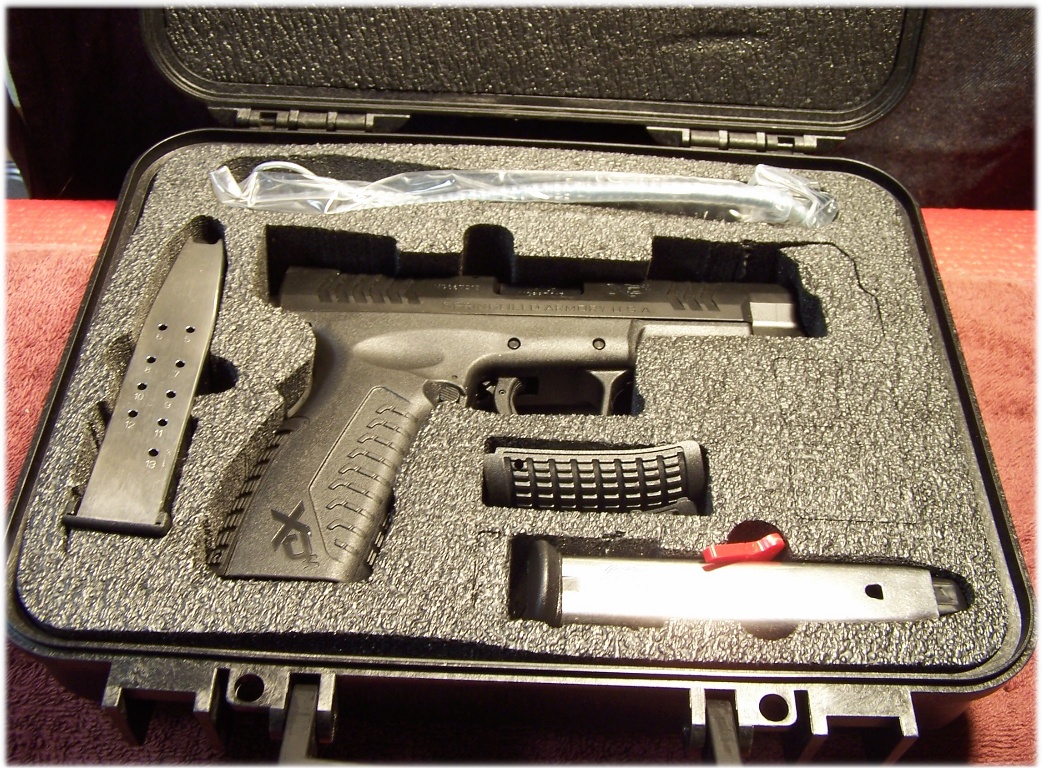 Here, I attempt to summarize, for myself as well as you, some reasons to consider the Springfield XDM 4.5.
Here, I attempt to summarize, for myself as well as you, some reasons to consider the Springfield XDM 4.5.
Cost/Benefit * * * * *
There are quite a few high-capacity .45 ACP pistols on the market; some of which are less expensive and some of which are more expensive. In my realm of reality, the FNH FNX45 is out of my reach in regard to cost. The Springfield XDM 4.5 is a good balance between cost and the benefit of ownership, in my opinion. High quality, ruggedness, reliability, capacity, and accuracy for a reasonable cost is a highly sought after commodity and the Springfield XDM 4.5 fits within, what I feel, is a good example of cost vs. benefit.
Fit & Finish * * * * *
I was pleased to find a flawless finish on both the outside and inside of the XDM. There were no visible machining marks, assembly marks, scuffs, or otherwise when I pulled it out of the box. The magazines slide home easily and freely and release just as well. All of the controls work as they are supposed to.
Reliability (In My Hands) * * * * *
To this point, the XDM 4.5 has shown that it is 100% reliable with the ammunition fired, and the magazines used, during the initial break-in phase.
Accuracy * * * *
Mechanically, the gun is very accurate. I have no doubt that the XDm 4.5 would stack bullets one atop the other in a more stable rest than I can provide. Depending upon your point-of-view regarding “match” triggers, the XDM 4.5 came from the factory with a stout trigger, especially for something with “match” inscribed on the side of the barrel. With that said, consistent trigger pull can make for consistent impacts on the target if you do your part. And, with that said, I found the trigger to be very predictable and consistent that, I am sure, helped me with my “accuracy” with the XDM 4.5.
Ergonomics * * * * *
Whereas a GLOCK G21 feels like a block of polymer and steel that shoots bullets, the XDM feels like it belongs in my hands. The controls are very easy to get to, and the ambidextrous mag release is a definite plus.
It can be said that moving from a slim single-stack 1911 to a thicker double-stack pistol takes some transition time. Conversely, it can be said that transitioning from a thicker double-stack pistol to a slim single-stack 1911 takes some time. I was feeling better about operating the XDM 4.5 by the time I completed the first range session. Of course, the more I handle the pistol, the more familiarity will grow – and familiarity with a good pistol also grows confidence in my ability to operate it.
Overall * * * *
A gun that goes boom every time is worth quite a bit, especially when it comes to EDC or competition guns. The XDM 4.5 is definitively MOBG accurate and head shots at ten yards, transitioning from center mess (sic) at a decent little clip, are well within the realm of even a mediocre operator such as me.
THE LAST WORD:
If you have been following my gun reviews at all, you know that I get to fire quite a few firearms and that the 1911 has been my primary carry for over thirty years. Yeah, that is hard to believe myself and trying to transition to a polymer, double-stack, high capacity .45 ACP carry piece is quite a jump for me.
The Springfield Armory XDM 4.5 was well-researched and comparisons made against other pistols in this genre, such as; the Glock G21, the S&W MP45, the new S&W M&P Shield in .45 ACP, the new Ruger American in .45 ACP, the FNH FX45, CZ97, SIG SAUER P227, and even the Ruger SR45, for example. The others did not make the cut for a variety of reasons to include capacity, cost, ergonomics, value, etc. I will have to say that I had to swallow my disdain of rails a bit as I am not a fan of them. If any of my pistols have a rail, it needs to be as subtle a rail as possible; the XDM 4.5 was on the borderline for me.
The Springfield Armory pistols speak of quality and my experiences with them (XD 4” Service Model, XDS 4.0 9mm, XDS 4.0 45ACP, 1911 Loaded, and 1911 RO Compact (let alone the M1A) has always left a good taste in my mouth regarding Springfield products. The XDM 4.5 in .45 ACP chambering is no exception. I can highly recommend one for range work, competition, home defense, and concealed carry in the right holster and with the proper clothing options.
In my search for a “I really like this pistol” I did my homework, shot range rentals, and relied on the words of others to guide me in my decision. So, check out the links in the next section and give a XDM 4.5, in whatever caliber, a new home.
The Springfield XDM 4.5 .45ACP pistol, whether in Melonite or Bi-tone Stainless-steel, just might appeal to you.
DON’ JUS’ TAKE MY WORD FOR IT:
In this section, I like to present links to the viewpoints of others.
- XDm 45: https://www.youtube.com/watch?v=VhchH6FFFsc
- XDm 45 vs Glock 21: https://www.youtube.com/watch?v=jo317hYV-ag
- SPRINGFIELD XDm .45 ACP REVIEW “CLOSE UP”: https://www.youtube.com/watch?v=3QXZFksfgOQ
- XDM 45 First Impressions: https://www.youtube.com/watch?v=_8yu4ixANPA
- Springfield XDM: Review and Update by Nutnfancy: https://www.youtube.com/watch?v=Rj0Kal84UNE
RESOURCES:
- Springfield Armory XDM: https://en.wikipedia.org/wiki/Springfield_Armory_XDM
- Match grade: https://en.wikipedia.org/wiki/Match_grade
![]()


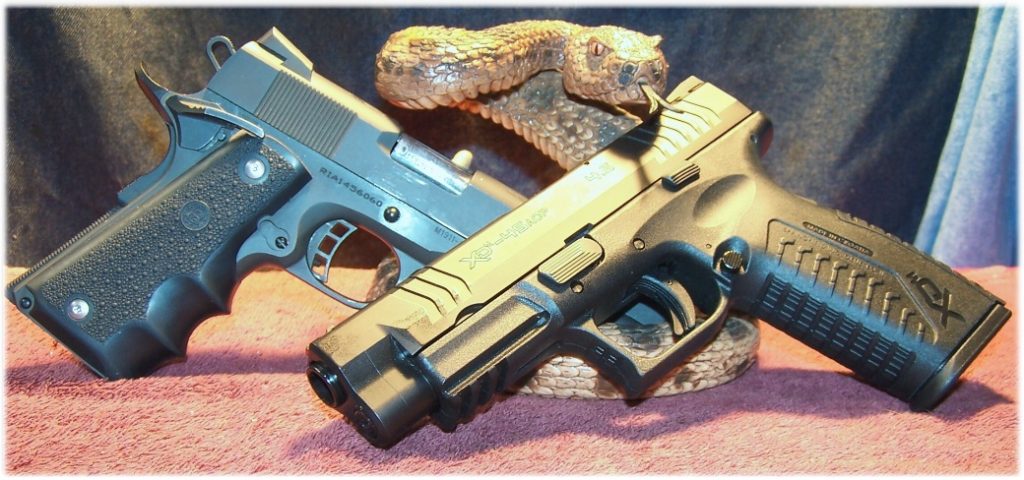
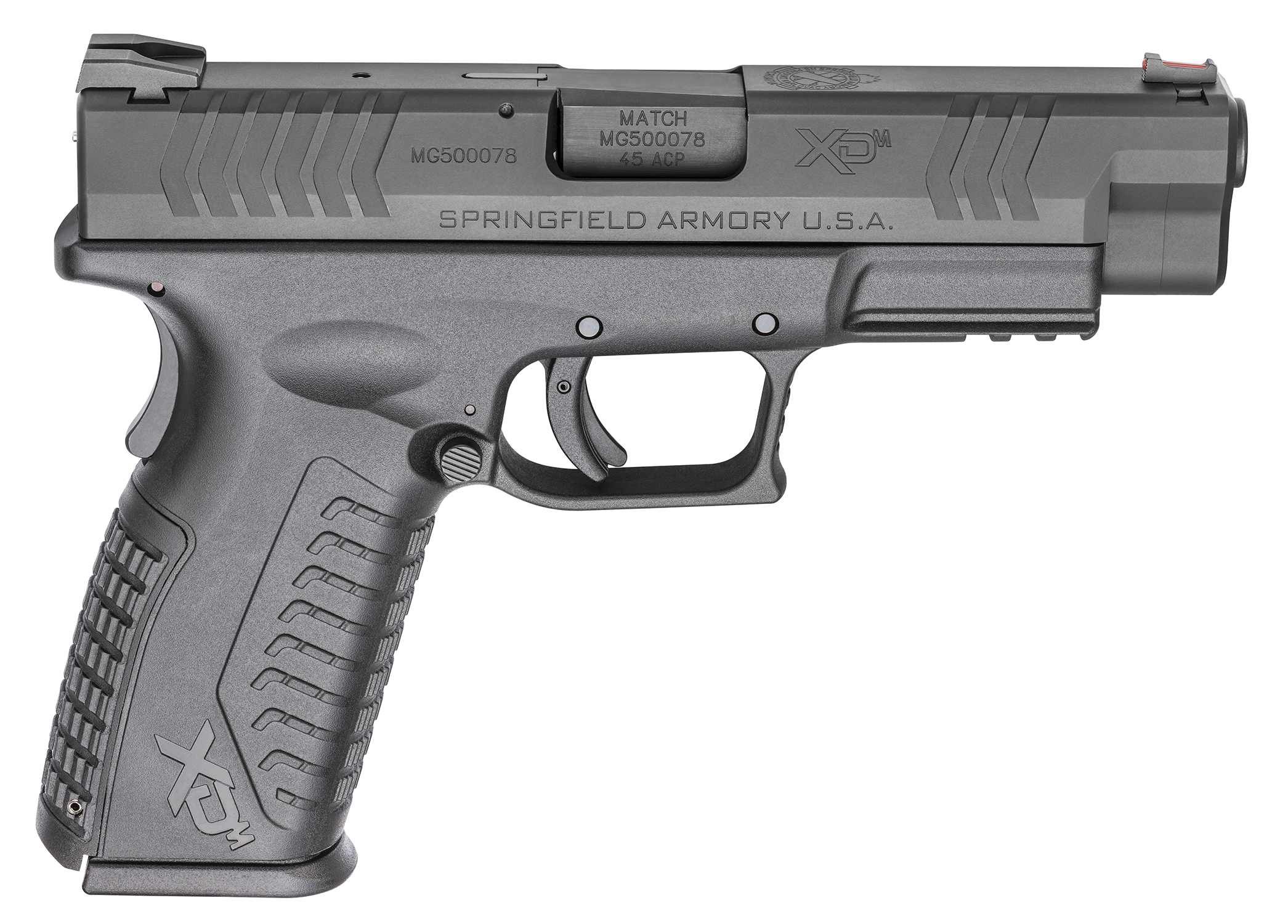
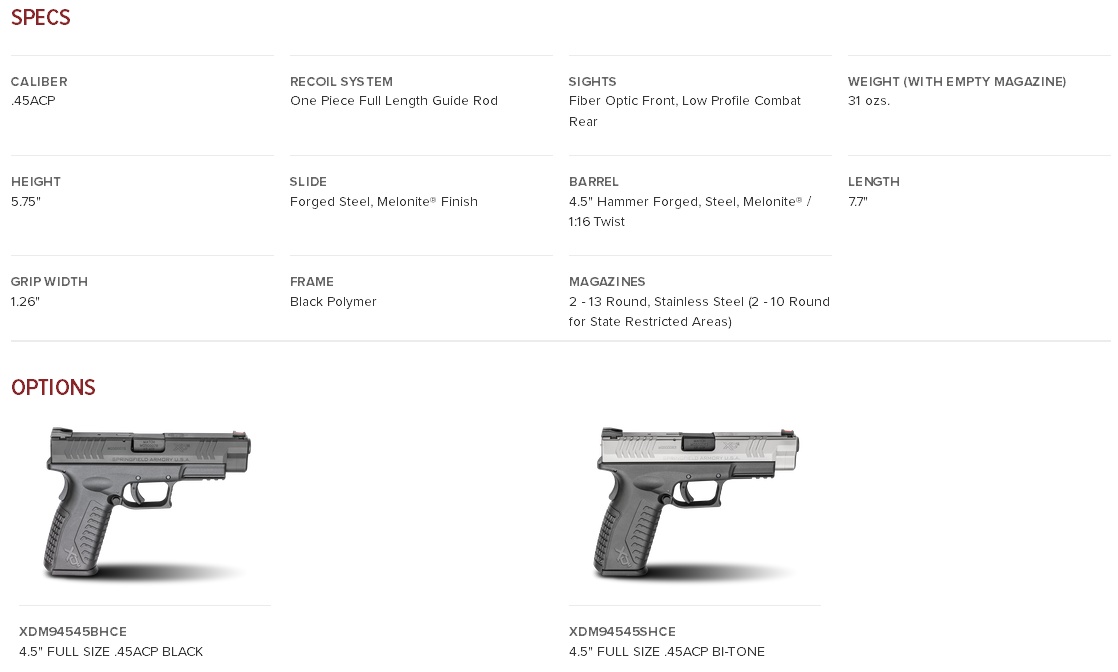
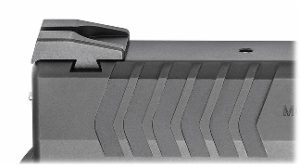
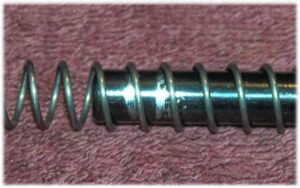

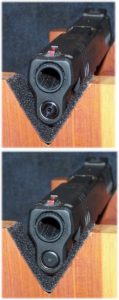
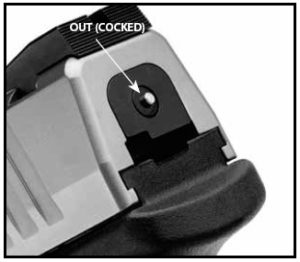
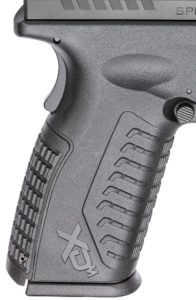
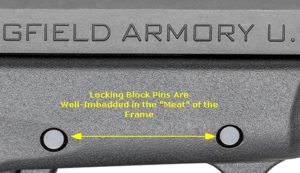
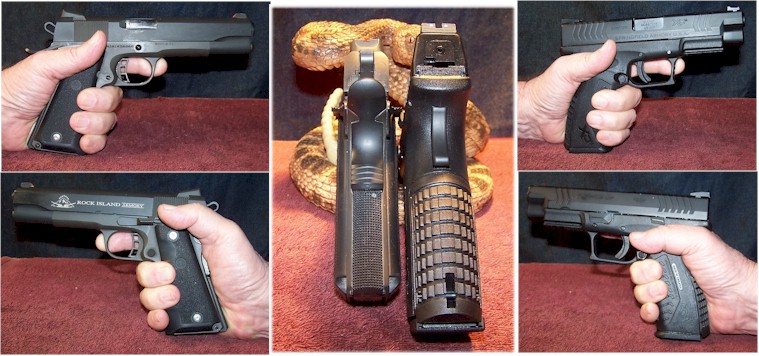
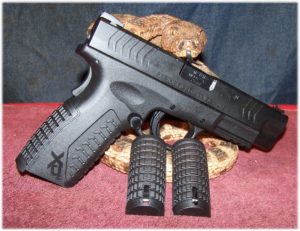
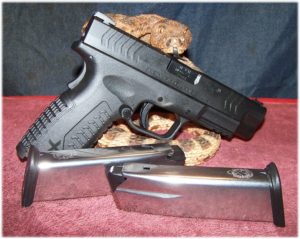
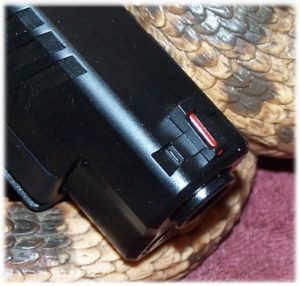




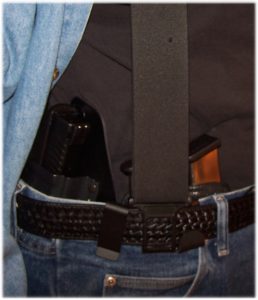
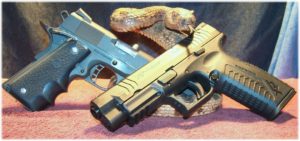
2 Responses to Springfield Armory XDM 4.5 .45ACP Pistol Review The Plot Thickens!